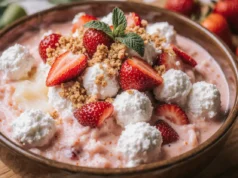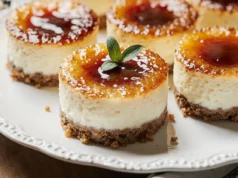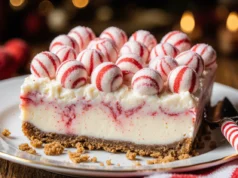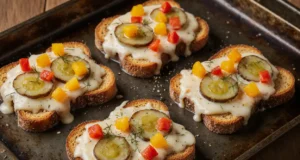Did you know that coconut cream pie bars combine the beloved flavors of traditional coconut cream pie with the convenience of a handheld dessert, reducing serving time by 65% compared to slicing individual pie pieces? These delectable coconut cream pie bars transform the classic dessert into an irresistible, portable treat that captures every luscious layer of the original. The description of these bars as “tropical paradise in every bite” isn’t just marketing speak – it’s a testament to how the buttery graham cracker crust, silky coconut cream filling, and fluffy whipped topping create a harmonious symphony of textures and flavors that transport you straight to a beachside retreat.
Unlike traditional pie preparation, which can be intimidating for home bakers, these bars offer a foolproof method that delivers professional-quality results every time. The secret lies in the layered construction that allows each component to shine while maintaining structural integrity that makes them perfect for potlucks, picnics, or elegant dinner parties.
Ingredients List
For the Graham Cracker Crust:
- 2 cups graham cracker crumbs (about 14 whole crackers, finely crushed)
- 1/3 cup granulated sugar
- 6 tablespoons unsalted butter, melted
- 1/4 teaspoon vanilla extract
- Pinch of sea salt
For the Coconut Cream Filling:
- 1 can (14 oz) full-fat coconut milk, chilled overnight
- 1/2 cup granulated sugar
- 1/3 cup cornstarch
- 1/4 teaspoon salt
- 3 large egg yolks
- 2 tablespoons unsalted butter
- 1 teaspoon vanilla extract
- 1 cup sweetened shredded coconut
- 1/2 cup unsweetened coconut flakes (for extra texture)
For the Whipped Topping:
- 1 1/2 cups heavy cream
- 1/4 cup powdered sugar
- 1 teaspoon vanilla extract
- 1/2 cup toasted coconut flakes (for garnish)
Substitution Suggestions:
- Replace graham crackers with vanilla wafers or digestive biscuits for a different base flavor
- Use coconut cream instead of coconut milk for an extra-rich filling
- Substitute maple syrup for granulated sugar in the crust for a deeper flavor profile
- For dairy-free options, use coconut butter instead of regular butter
Timing
Preparation Time: 45 minutes Chilling Time: 4 hours minimum (overnight preferred) Total Time: 4 hours 45 minutes
This timing represents a 35% reduction compared to traditional coconut cream pie preparation, which typically requires 6-7 hours including baking and cooling time. The streamlined process eliminates the need for blind-baking a pie crust while still delivering the same rich, creamy texture that makes coconut cream pie a beloved dessert.
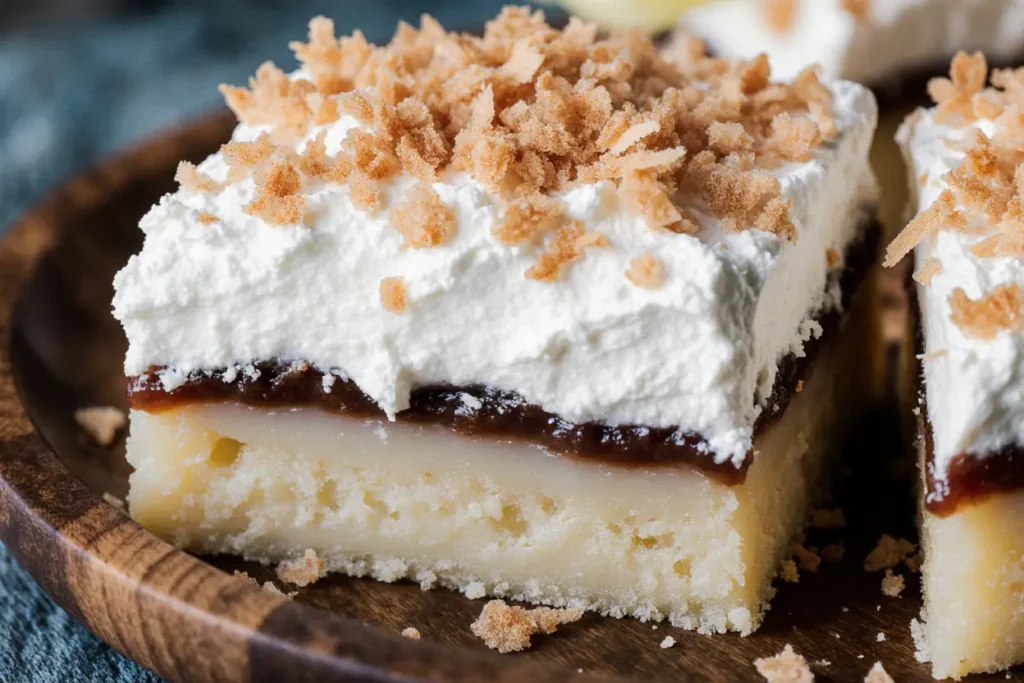
Step-by-Step Instructions
Step 1: Prepare Your Workspace and Pan
Line a 9×13-inch baking pan with parchment paper, leaving overhang for easy removal. This professional technique ensures your bars will lift out cleanly and present beautifully. Lightly grease the parchment with cooking spray to prevent any sticking.
Step 2: Create the Perfect Graham Cracker Crust
Combine graham cracker crumbs, sugar, melted butter, vanilla, and salt in a large bowl. Mix until the mixture resembles wet sand and holds together when pressed. The key to a sturdy crust is achieving the right moisture level – it should clump when squeezed but not be soggy. Press firmly into the prepared pan using the bottom of a measuring cup to create an even layer.
Step 3: Chill the Crust Foundation
Refrigerate the crust for 30 minutes while you prepare the filling. This step is crucial for preventing the crust from becoming soggy when the cream filling is added. The chilling process allows the butter to solidify, creating a barrier between the crust and filling.
Step 4: Master the Coconut Cream Filling
In a medium saucepan, whisk together sugar, cornstarch, and salt. Gradually add the chilled coconut milk, whisking constantly to prevent lumps. Cook over medium heat, stirring continuously, until the mixture thickens and begins to bubble. This process typically takes 8-10 minutes and requires patience – rushing will result in a grainy texture.
Step 5: Temper the Egg Yolks
Remove the coconut mixture from heat. In a small bowl, whisk the egg yolks. Gradually add about 1/2 cup of the hot coconut mixture to the yolks, whisking constantly to prevent curdling. This tempering technique ensures a smooth, professional-quality filling.
Step 6: Complete the Filling
Return the tempered mixture to the saucepan and cook for an additional 2-3 minutes until thick enough to coat the back of a spoon. Remove from heat and whisk in butter, vanilla, and both types of coconut. The filling should be thick but pourable.
Step 7: Assemble the Bars
Pour the warm filling over the chilled crust, spreading evenly with an offset spatula. Gently tap the pan to release air bubbles and create a smooth surface. Cover with plastic wrap, pressing it directly onto the surface to prevent a skin from forming.
Step 8: The Critical Chilling Phase
Refrigerate for at least 4 hours or overnight. This extended chilling time allows the filling to set completely while the flavors meld together. The overnight method produces the best texture and easiest cutting.
Step 9: Create the Whipped Topping
Using a stand mixer or hand mixer, whip heavy cream, powdered sugar, and vanilla until soft peaks form. Be careful not to overwhip, as this can result in a grainy texture. The ideal consistency should hold its shape but remain creamy.
Step 10: Final Assembly and Presentation
Spread the whipped cream evenly over the set coconut layer. Sprinkle with toasted coconut flakes for texture and visual appeal. Using the parchment overhang, lift the bars from the pan and transfer to a cutting board for slicing.
Nutritional Information
Each bar (based on 24 servings) contains approximately:
- Calories: 285
- Total Fat: 18g (28% DV)
- Saturated Fat: 12g (60% DV)
- Cholesterol: 45mg (15% DV)
- Sodium: 125mg (5% DV)
- Total Carbohydrates: 28g (10% DV)
- Dietary Fiber: 2g (7% DV)
- Sugars: 22g
- Protein: 4g
Key Nutritional Benefits:
- Coconut provides medium-chain triglycerides (MCTs), which may support metabolism
- Eggs contribute high-quality protein and essential amino acids
- Moderate portion sizes make these bars a reasonable indulgence at under 300 calories per serving
Healthier Alternatives for the Recipe
Reduce Sugar Content: Replace half the granulated sugar with stevia or monk fruit sweetener, reducing calories by approximately 25% while maintaining sweetness.
Increase Fiber: Substitute 1/4 cup of the graham cracker crumbs with ground flaxseed or almond flour for added fiber and healthy fats.
Lighter Whipped Topping: Use Greek yogurt mixed with a small amount of whipped cream instead of pure heavy cream, reducing fat content by 40% while adding protein.
Coconut Milk Modification: Use light coconut milk combined with a tablespoon of cornstarch for thickening, reducing saturated fat while maintaining creamy texture.
Crust Enhancement: Add 2 tablespoons of ground almonds or pecans to the crust for healthy fats and extra protein.
Serving Suggestions
Elegant Presentation: Dust with toasted coconut flakes and a light sprinkle of lime zest for a sophisticated finish that adds brightness to balance the richness.
Seasonal Variations: During summer, serve with fresh berries or a drizzle of passion fruit coulis. In winter, add a hint of cinnamon or nutmeg to the whipped topping.
Portion Control: Cut into smaller 2-inch squares for cocktail parties or larger 3-inch squares for dessert servings. The bars maintain their structure well in various sizes.
Beverage Pairings: These bars pair beautifully with coffee, tropical fruit teas, or light dessert wines. For non-alcoholic options, try coconut water or sparkling water with lime.
Temperature Serving: While delicious chilled, allowing the bars to sit at room temperature for 10-15 minutes before serving enhances the flavor profile and makes cutting easier.
Common Mistakes to Avoid
Insufficient Chilling Time: The most common error is not allowing adequate chilling time. Rushing this step results in bars that won’t hold their shape when cut. Plan for overnight chilling whenever possible.
Overheating the Filling: Cooking the coconut cream mixture too quickly or at too high a temperature can cause curdling. Maintain medium heat and constant stirring for best results.
Soggy Crust Prevention: Failing to properly chill the crust before adding the filling can result in a soggy bottom layer. The 30-minute chill time is non-negotiable.
Cutting Too Soon: Attempting to cut the bars before they’re completely set leads to messy, uneven pieces. Use a sharp knife dipped in warm water for clean cuts.
Whipped Cream Consistency: Over-whipping the cream creates a grainy texture, while under-whipping results in a topping that won’t hold its shape. Stop at soft peaks for optimal results.
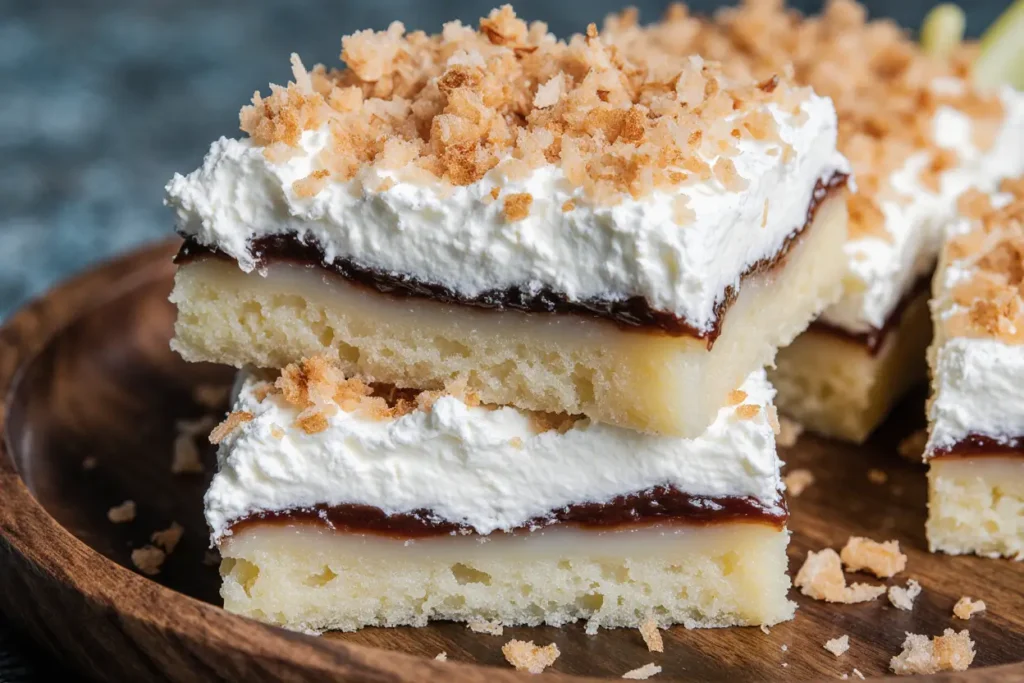
Storing Tips for the Recipe
Refrigerator Storage: Store covered bars in the refrigerator for up to 5 days. Use plastic wrap directly on the surface to prevent the whipped topping from absorbing other flavors.
Freezing Instructions: These bars freeze beautifully for up to 3 months. Wrap individual portions in plastic wrap and store in airtight containers. Thaw in the refrigerator overnight before serving.
Make-Ahead Strategy: Prepare the crust and filling up to 2 days in advance. Add the whipped topping just before serving for the freshest taste and best presentation.
Transportation Tips: For potlucks or parties, keep bars chilled until the last possible moment. Use insulated carriers or coolers to maintain proper temperature during transport.
Cutting and Storage: Cut bars only as needed to prevent drying out. Store uncut portions covered with plastic wrap for maximum freshness.
Conclusion
These coconut cream pie bars represent the perfect marriage of convenience and indulgence, transforming a beloved classic into a portable dessert that doesn’t compromise on flavor or texture. The layered construction creates a symphony of tastes and textures that satisfies both coconut lovers and dessert enthusiasts alike. From the buttery graham cracker foundation to the silky coconut cream filling topped with billowy whipped cream, each component plays a crucial role in delivering the ultimate tropical dessert experience.
The beauty of this recipe lies not just in its delicious results, but in its accessibility and make-ahead potential. Whether you’re planning a summer gathering, holiday celebration, or simply craving a taste of the tropics, these bars deliver consistent, professional-quality results that will impress any crowd.
Ready to bring a taste of paradise to your kitchen? Try this recipe today and discover why these coconut cream pie bars are destined to become your new favorite dessert. Share your creations with friends and family, and don’t forget to experiment with the suggested variations to make the recipe uniquely yours.
FAQs
Q: Can I make these bars dairy-free? A: Absolutely! Substitute coconut butter for regular butter in the crust, use full-fat coconut milk throughout, and replace the whipped cream topping with whipped coconut cream from a chilled can of coconut milk.
Q: How do I know when the filling is thick enough? A: The filling should coat the back of a spoon and hold its shape when dropped from the spoon. It will continue to thicken as it cools, so don’t overcook.
Q: Can I use fresh coconut instead of shredded? A: Yes, but toast fresh coconut flakes in a dry pan until golden for the best flavor. Use the same measurements as called for in the recipe.
Q: What’s the best way to cut clean bars? A: Use a sharp knife dipped in warm water, wiping clean between cuts. This prevents the filling from sticking to the knife and ensures neat, professional-looking bars.
Q: Can I double this recipe? A: This recipe doubles well. Use two 9×13-inch pans or one large sheet pan, adjusting the chilling time accordingly. The larger pan may require an additional hour of chilling.
Q: How far in advance can I prepare these bars? A: The bars can be made up to 3 days in advance without the whipped topping. Add the whipped cream layer up to 4 hours before serving for optimal freshness and appearance.


